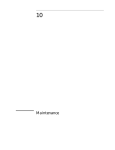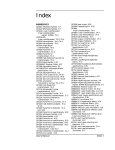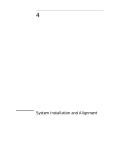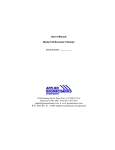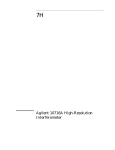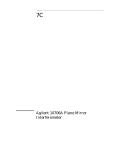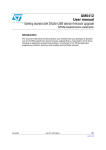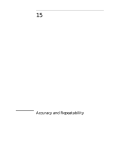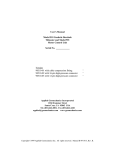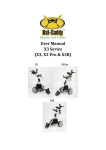Download Chapter 6 Beam-Directing Optics
Transcript
6 Beam-Directing Optics Beam Manipulators Chapter 6 Beam-Directing Optics Introduction Introduction This chapter describes the Agilent beam-directing optics available for laser measurement systems. In general, the beam-splitting and beam-bending optics are used only for making right-angle turns when routing the laser beam within the intended application. The right-angle turns must be aligned parallel to or perpendicular to the mounting plane of the laser head, to minimize polarization effects. This confines beam turning to one of four possible directions. For instance, for a horizontal laser beam, with polarizations oriented vertically and horizontally, the options are up, down, left, and right. Beam translators are used to ensure that the translated or offset laser beam remains parallel to the original beam direction. The translator is useful whenever a high precision distance measurement with a laser is performed because it can reduce Abbé error. Table 6-1 summarizes the beam-directing optics and the Agilent adjustable optics mounts with which they may be used. (The mounts are described in Chapter 9, “Accessories,” of this manual.) Specification drawings of the optics described in this chapter are provided as part of the descriptions. Agilent Technologies measurement optics available are described in Chapter 7, “Measurement Optics,” of this manual. Optics that are 1) not interferometers, and 2) not usually referred to as “beam-directing optics” are described in Chapter 9, “Accessories,” of this manual. 6-2 User’s Manual Chapter 6 Beam-Directing Optics Introduction Table 6-1. Beam-direction optics Beam-Directing Optics Order as required to manipulate beam path for your application Agilent 10567A Dual Beam Beam Splitter, useful in vacuum applications Agilent 10700A 33% Beam Splitter Agilent 10701A 50% Beam Splitter Agilent 10707A Beam Bender Agilent 10725A 50% Beam Splitter (requires user-supplied mounting hardware) Agilent 10726A Beam Bender (requires user-supplied mounting hardware) Adjustable Mounts for optics above Adjustable mounts simplify installation and alignment of optics Agilent 10710B Use with Agilent 10700A, 10701A, 10707A Agilent 10711A Use with Agilent 10702A, 10706A, 10706B, 10715A, 10716A Precision Beam Manipulators Use in multiaxis laser measurement systems Agilent N1203C Precision Beam Translator Agilent N1204C Precision Horizontal Beam Bender Agilent N1207C Precision Vertical Beam Bender All Agilent laser systems can use the same Agilent 107XX series of optics. However, keep in mind: • The Agilent 10719A and Agilent 10721A interferometers are designed to use the 3 mm (nominal) diameter beam from the Agilent 5517C-003 Laser Head. Any of the beam-directing optics described here can be used in the laser beam delivery system between the laser head and the interferometer(s). • The Agilent 10735A, Agilent 10736A, and Agilent 10736A-001 interferometers can use a laser beam with a (nominal) diameter up to 9 mm. The 9 mm beam, available from an Agilent 5517C-009 Laser head, provides a greater yaw range than either the standard 6 mm beam or the 3 mm beam. Any of the beam-directing optics described here can be used in the laser beam deliver system between the laser head and the interferometer(s). However, when a 9 mm beam is used with any of these beam-directing optics except for the Agilent 10725A 50% Beam Splitter or the Agilent 10726A Beam Bender, a portion of the beam may be clipped, which will reduce the yaw range of the interferometer(s) receiving that beam. User’s Manual 6-3 Chapter 6 Beam-Directing Optics Use of the Adjustable Mounts • The Agilent 10725A beam splitter and the Agilent 10726A beam bender provide the same optical components as the Agilent 10701A beam splitter and the Agilent 10772A Turning Mirror or Agilent 10773A Flatness Mirror, respectively. The difference is that in the Agilent 10701A, Agilent 10772A, and Agilent 10773A, the optical elements are already installed in mounting hardware. The Agilent 10725A beam splitter and Agilent 10726A beam bender require custom user-supplied mounts. The Agilent 10772A Turning Mirror and the Agilent 10773A Flatness Mirror are described in Chapter 9, “Accessories,” of this manual. Use of the Adjustable Mounts NOTE The Agilent N1203C, N1204C, and N1207C beam manipulators DO NOT use the adjustable mounts. See “Agilent N1203C, N1204C, and N1207C Beam Manipulators” in this chapter for details on these products. Aligning an Agilent laser measurement system may require adjusting the position of one of more of its optical components, especially the beam-directing optics in the path(s) between the laser head and the interferometer(s). The Agilent 10710B and Agilent 10711A adjustable mounts should be used to provide the adjustment capability for most optical components. In general, the alignment procedures are performed with all optical components in place. Your measurement system design should allow for adjustment of the laser, optics, and receivers during alignment. Vacuum Applications Vacuum options are available for Agilent beam-directing optics (except those requiring user-supplied mounting hardware) listed in Table 6-1. Contact Agilent Call Center for information (telephone numbers of various call centers are listed on the “Service and Support” page at the back of this manual). The vacuum option components use vacuum-grade adhesives in their construction, and may be used in vacuum applications. Use of the Agilent 10725A Beam Splitter, Agilent 10726A Beam Bender, in a vacuum application depends on the materials used in the user-created mounting arrangement. 6-4 User’s Manual Chapter 6 Beam-Directing Optics Agilent 10567A Dual Beam Beam-Splitter Agilent 10567A Dual Beam Beam-Splitter The Agilent 10567A Dual Beam Beam-Splitter (Figure 6-1) divides the laser beam into two beams perpendicular to each other (see Figure 6-2) and directs them to two sets of measurement optics. The return beams pass through the Agilent 10567A again and exit parallel to the input beam. This beam-splitter is typically used for applications where two axes of measurement are required to go through a window, such as a window in a vacuum chamber. 105 BE 67A AM S L P ER T IT 10 56 7A Agilent 10567A Dual Beam Beam-Splitter Figure 6-1. Agilent 10567A Dual Beam Beam-Splitter AGILENT 10567A DUAL BEAM BEAM-SPLITTER LASER BEAM Vacuum Chamber To Interferometer From Interferometer Agilent 10780C Y Axis Receiver To Interferometer Laser Agilent 10780C X Axis Receiver Agilent 10567A Beam Splitter From Interferometer Window Figure 6-2. Agilent 10567A Dual Beam Beam-Splitter — laser beam path User’s Manual 6-5 Chapter 6 Beam-Directing Optics Agilent 10567A Dual Beam Beam-Splitter Agilent 10567A Dual Beam Beam-Splitter Specifications Dimensions: See drawings below. Weight: 325 grams (11.5 ounces) Materials Used: Housing: Aluminum Optics: Optical Grade Glass Adhesives: Low Volatility (Vacuum Grade) Optical Efficiency: Typical: 45% (each beam) Worst Case: 39% (each beam) 8/32 UNC 4 Holes All Faces Exit Return TYP 35.6mm (1.40) 19.1 mm (0.75) 12.7 mm (0.50) Exit 12.7mm (0.50) Entrance 7A BEAM SPL I 12.7 mm (0.50) ER TT 53.3 mm (2.10) 105 6 Return Return 10567A 12.7mm (0.50) 50.8 mm (2.00) 21.6 mm (0.85) 19.1 mm (0.75) Return Figure 6-3. Agilent 10567A Dual Beam Beam-Splitter — dimensions 6-6 User’s Manual Chapter 6 Beam-Directing Optics Agilent 10700A 33% Beam Splitter and 10701A 50% Beam Splitter Agilent 10700A 33% Beam Splitter and 10701A 50% Beam Splitter Each of these optics directs part of the laser beam along a second axis. Combinations of these optics may be used to split the single laser head beam into multiple parts for multiaxis measurements. The beam splitters are rugged and easy to mount, offering considerable flexibility in their mounting arrangements. The Agilent 10700A 33% Beam Splitter deflects one-third of the laser beam intensity perpendicular to the original beam direction while the remaining two-thirds continues through the optic. The Agilent 10701A 50% Beam Splitter operates in a similar manner with a 50% ratio of beam splitting. BEAM S 50% 33% By using combinations of these two accessories, the beam may be split into several paths to perform multiaxis measurements. For example, using a 33% and a 50% Beam Splitter, one-third of the laser beam intensity can be directed to each measurement axis in a three-axis machine. P BEAM S P L L TER TER IT IT 10 70 0A Agilent 10700A 33% Beam Splitter 10 70 1A Agilent 10701A 50% Beam Splitter Figure 6-4. Agilent 10700A 33% Beam Splitter and Agilent 10701A 50% Beam Splitter User’s Manual 6-7 Chapter 6 Beam-Directing Optics Agilent 10700A 33% Beam Splitter and 10701A 50% Beam Splitter Agilent 10700A 33% Beam Splitter Specifications Dimensions: See drawings below. Weight: 62 grams (2.2 ounces) Materials Used: Housing: Stainless Steel Optics: Optical Grade Glass Adhesives: Low Volatility (Vacuum Grade) Optical Efficiency: 33% Path: typical 30%, worst case 27% 33 % 67% Path: typical 63%, worst case 61% AM S BE 0.8 mm (0.03) Offset 0A 19.6 mm (0.77) Typ #6-32 UNC. Thru Clearance For #4 or (2.5 mm) 2 Places 10.16 mm Aperture Dia (0.40) 25.4 mm (1.0) Center Line #4-40 (0.15 Deep) 2 Places 19.6 mm (0.77) Typ 25.4 mm (1.0) Figure 6-5. Agilent 10700A 33% Beam Splitter — dimensions 6-8 User’s Manual Chapter 6 Beam-Directing Optics Agilent 10700A 33% Beam Splitter and 10701A 50% Beam Splitter Agilent 10701A 50% Beam Splitter Specifications Dimensions: See drawings below. Weight: 62 grams (2.2 ounces) Materials Used: Housing: Stainless Steel Optics: Optical Grade Glass Adhesives: Low Volatility (Vacuum Grade) Optical Efficiency: Typical: 45% (each beam) AM S L BE T ER 50 % Worst Case: 39% (each beam) 19.6 mm (0.77) 0.8 mm (0.03) Offset #6-32 UNC. Thru Clearance For #4 or (2.5 mm) 2 Places 10.16 mm Aperture Dia (0.40) 25.4 mm (1.0) Center Line #4-40 (0.15 Deep) 2 Sides 19.6 mm (0.77) 25.4 mm (1.0) Figure 6-6. Agilent 10701A 50% Beam Splitter — dimensions User’s Manual 6-9 Chapter 6 Beam-Directing Optics Agilent 10707A Beam Bender Agilent 10707A Beam Bender The Agilent 10707A Beam Bender contains a 100% reflectance mirror which turns the direction of an incoming laser beam 90 degrees. To maintain proper polarizations, only right-angle turns should be used in routing the laser beam. BEAM B E N D ER 10 70 7A Agilent 10707A Beam Bender Figure 6-7. Agilent 10707A Beam Bender 6-10 User’s Manual Chapter 6 Beam-Directing Optics Agilent 10707A Beam Bender Agilent 10707A Beam Bender Specifications Dimensions: See drawings below. Weight: 58 grams (2.1 ounces) Materials Used: Housing: Stainless Steel Optics: Optical Grade Glass Adhesives: Low Volatility (Vacuum Grade) Optical Efficiency: Typical: 99% Worst Case: 98% #4-40 (0.15 Deep) 2 Sides 25.4 mm (1.0) Center Line 19.6 mm (0.77) Typ 25.4 mm (1.0) #6-32 UNC Thru Clearance For #4 or (2.5 mm) 2 Places AM BE 19.6 mm (0.77) Typ 10707A Figure 6-8. Agilent 10707A Beam Bender — dimensions User’s Manual 6-11 Chapter 6 Beam-Directing Optics Agilent 10725A 50% Beam Splitter and 10726A Beam Bender Agilent 10725A 50% Beam Splitter and 10726A Beam Bender These devices are designed for use in a laser measurement system that includes an Agilent 10735A or a standard Agilent 10736A Three-axis Interferometer or an Agilent 10736A-001 Three-axis Interferometer with Beam Bender. They are designed to handle the 9 mm beam from an Agilent 5517C-009. The Agilent 10725A beam splitter is the same optical element as that used in the Agilent 10701A, described above, except that the Agilent 10725A is supplied without a housing. The Agilent 10726A bender is the same optical element as that used in the Agilent 10772A turning mirror or Agilent 10773A flatness mirror, described in Chapter 9, “Accessories,” except that the Agilent 10726A is supplied without a housing. CAUTION Agilent Technologies does not provide mounting hardware for the Agilent 10725A beam splitter or the Agilent 10726A beam bender. These devices are intended for use in user-designed mounts. The user is responsible for devising a mounting method that does not cause stresses in the optical devices that will result in distortion of the reflected laser wavefronts. Agilent 10725A Beam Splitter Specifications Use: Split a laser beam having a diameter up to 9 mm (nominal). This beam splitter requires a user-supplied mount. This optic can be made vacuum compatible. Dimensions: See drawings below. Weight: 2 grams (0.07 ounce) Materials Used: Optic, Fused silica Optical Efficiency: Typical: 45% (each beam) Worst Case: 39% (each beam) 6-12 User’s Manual Chapter 6 Beam-Directing Optics Agilent 10725A 50% Beam Splitter and 10726A Beam Bender 2.41 mm (.09) 19.3 mm Dia (0.76) Minimum Clear Aperture 16.51 mm (0.65) Concentric to O.D. Figure 6-9. Agilent 10725A 9mm Laser Beam Splitter — dimensions Agilent 10726A Beam Bender Specifications Use: Bend a laser beam having a diameter up to 9 mm (nominal). This beam bender requires a user-supplied mount. This optic can be made vacuum compatible. Dimensions: See drawings below. Weight: 10 grams (0.35 ounce) Materials Used: Optic, Fused silica Optical Efficiency: Typical: 99% Worst Case: 98% Minimum Clear Aperture Central 19.05 mm (0.75) × 26.92 mm (1.06) 30.48 mm (1.20) 45° 22.0 mm (0.87) 5.59 (0.22) 7.62 (0.30) Figure 6-10. Agilent 10726A 9mm Laser Beam Bender — dimensions User’s Manual 6-13 Chapter 6 Beam-Directing Optics Agilent N1203C, N1204C, and N1207C Beam Manipulators Agilent N1203C, N1204C, and N1207C Beam Manipulators Overview The purpose of the Agilent N1203C, N1204C, and N1207C beam manipulators (shown in Figure 6-11) is to precisely bend or translate a laser beam to achieve sub-nanometer distance measurements. The precise bending and translating results in a properly aligned laser beam. An improperly aligned laser system will produce errors. The beam manipulators are very useful in rapid laser system alignment used for precision distance measurements. The Agilent N1203C Precision Beam Translator is a precision optical mount for a refracting window. The Agilent N1204C Precision Horizontal Beam Bender and Agilent N1207C Precision Vertical Beam Bender are precision optical mounts for bending mirrors. These products are designed to provide high resolution positioning of laser beams for precise distance measurements by the application of removable tooling (see “Agilent N1203C/04C/07C Beam Manipulator Accessories” in Chapter 9, “Accessories” of this manual for details on the adjustment tool kit). Once the adjustment is completed and tools removed, this mount will provide long-term stability of the initial setting in the presence of specified thermal, shock and vibration environments. The Agilent N1203C translates the beam so that the measurement beam is positioned where you want it on the stage mirror. The offset laser beam remains parallel to the original beam direction. The translator is useful whenever a high precision distance measurement with a laser is performed because it can reduce Abbé error. The Agilent N1204C and N1207C steer the laser beam in angle in either the horizontal or vertical plane. The beam bender’s optical component (a mirror) is intended to turn the laser beam 90° relative to the original beam direction. The beam bender is useful whenever high precision distance measurements with a laser is performed because it can reduce cosine error. Application simplified These beam manipulators are easier to use and more durable than previous versions. The manipulators provide more stability to laser measurement systems than previous solutions. The operator merely aligns the manipulator with removable tools. The operator need not perform the secondary clamping operation. The manipulators are already clamped. 6-14 User’s Manual Chapter 6 Beam-Directing Optics Agilent N1203C, N1204C, and N1207C Beam Manipulators OR 03CC NN112203 L NS AT PRE C I SI O N B E A M TRA Agilent N1203C Precision Beam Translator 03CC NN112204 0 7C OR BE N DER N12 L NS C I SI O N B E A M TRA Agilent N1204C Precision Horizontal Beam Bender EA M AT PRE PRE C I S I O N V E R TI B CAL Agilent N1207C Precision Vertical Beam Bender Figure 6-11. Agilent precision beam manipulators Stability Thermal The Agilent N1203C, N1204C, and N1207C beam manipulators exhibit improved thermal stability since all components of the manipulator are of the same material, and the ball is suspended symmetrically in a spring nest. The symmetry of this design enables the contact points between the ball and the springs to remain precisely the same as the temperature changes. Hence, as the temperature changes, there is no rotation imparted to the ball. Mechanical The beam manipulator feet are designed not to slip due to differential thermal expansion between the stainless steel housing and an Invar mounting plate in the presence of an environmental temperature change of up to 20° C. Thus, there will be no unrecoverable beam User’s Manual 6-15 Chapter 6 Beam-Directing Optics Agilent N1203C, N1204C, and N1207C Beam Manipulators displacement due to foot slippage when mounted to any material whose CTE is in the range of 1.6 × 10-6/° C to 21.8 × 10-6/° C provided the feet are secured with the specified bolt torque value (see the specifications and characteristic sections for the beam manipulators at the end of this chapter). Optical Input/Output ports and adjustment access The Agilent N1203C, N1204C, and N1207C manipulators have six input and output (I/O) ports. There is only one mounting face. From this one mounting, either horizontal or vertical bends in any direction may be accomplished. Adjustment tools may be attached at any of ten access ports, allowing two of the I/O ports for entrance and exit of the laser beam. See the Agilent N1203C Precision Beam Translator and Agilent 1204C and N1207C Precision Beam Benders User’s Guide for details on mounting, aligning, adjusting, etc. of these beam manipulators. 6-16 User’s Manual Chapter 6 Beam-Directing Optics Agilent N1203C, N1204C, and N1207C Beam Manipulators Agilent N1203C Precision Beam Translator Specifications and Characteristics Dimensions: See Figure 6-12. Weight: 920 grams Materials Used: Martensitic stainless steel Optical grade glass Optical Efficiency: 99% typical 98.7% Worst case Input/Output Clear Aperture: φ 19.0 mm Input Beam Position Tolerance: ± 5mm (Note: input beam de-centering may limit translation range. See range specification below.) Beam Translation Range (from input at normal incidence on center of clear aperture): ± 3 mm with φ 9 mm beam ± 4.0 mm with φ 6 mm beam ± 4.4 mm with φ 3 mm beam Transmitted Beam Deviation: ± 10 microradian maximum Beam Translation Sensitivity/Resolution: 1.0 micrometer Thermal Drift: ∆D Translated Beam Displacement per ° C = -------- = 100 nm per ° C ∆T Shift of output beam position is theroretically possible in the presence of a thermal gradient in the assembly, but the refractive translator is quite insensitive to small angular changes. Nevertheless, even these miniscule shifts are transitory and the original position is recovered when the gradient has settled out. Thermal Stability of Alignment: Ball to Housing Beam position alignment is fully recoverable over a slow environmental temperature change of 20° C provided there are no sharp thermal gradients within the assembly (i.e., ∆D/∆T ~20° C/hr.) Housing to Mounting Plate The Manipulator feet are designed not to slip due to differential thermal expansion between the stainless steel housing and an Invar mounting plate in the presence of an environmental temperature change of 20° C. Thus, there should be no unrecoverable beam displacement due to foot slippage when mounted to any material whose CTE is in the range of 1.6 × 10-6/° C to 21.8 × 10-6/° C provided the feet are secured with the specified bolt torque value. Resonant Frequencies: Ball and Spring Suspension The laser beam Manipulator comprises a very stiff, nonlinear spring-mass system. At shock levels below the shock damage threshold it is not possible to excite a free vibration resonance in the ball suspension. This is due to three phenomena: 1. Prestress stiffening due to compression of the springs in final assembly. 2. Stiffening due to geometrical deformation of the beam springs as a result of the compressive load. 3. Frictional damping between ball and springs. User’s Manual 6-17 Chapter 6 Beam-Directing Optics Agilent N1203C, N1204C, and N1207C Beam Manipulators Resonant Frequencies (Continued): Ball and Spring Suspension (Continued) The natural resonance of the spring-mass system (350 Hz) is completely supressed by these effects. The first FFT measured resonance in the assembly is at 3.5 kHz, which is the Ball itself. The next resonance is at 3.7 kHz, which is the Housing: Thus, there is no resonance which could disturb laser beam alignment or position in the operating environment. Shock: Operating: 40 g, half sine, 2.9 ms A shock load of 40 g, half sine, 2.9 ms will not disturb the alignment of the Ball, Refractive Translator or laser beam. Non Operating: 60 g, half sine, 2.9 ms A shock load of 60 g, half sine, 2.9 ms will not damage the Manipulator components, but may disturb alignment of the Ball. Recommended Mounting Screws: Four screws M5×20 long Alloy Steel; Grade 12.9: Seating Torque is 5 N.m if Cadmium plated, or 6.5 N.m if unplated. OR Four screws 10-32 UNF × .75 inches long Alloy Steel: Seating Torque is 39 in-lbs if Cadmium plated, or 51 in-lbs if unplated. Adjustment Tooling: 5 mm Hex-key wrench 6-18 User’s Manual Chapter 6 Beam-Directing Optics Agilent N1203C, N1204C, and N1207C Beam Manipulators Agilent N1204C Precision Horizontal Beam Bender Specifications and Characteristics Dimensions: See Figure 6-12. Weight: 920 grams Materials Used: Martensitic stainless steel Optical grade glass Optical Efficiency: 99% typical 97.5% Worst case Input/Output Clear Aperture: φ 13.0 mm Input Beam Position Tolerance: ± 1.6 mm for φ 9 mm beam Angular Beam Steering Range (from nominal 90°, φ 9 mm beam centered on φ 13 mm Aperture): Yaw: ± 6° (using Adjustment Lever and adapter at φ25 mm port ) Pitch: ± 3° (using Adjustment Lever and adapter at φ25 mm port) Yaw: ± 1° (using Adjustment Lever only, at φ9 mm port ) Pitch: ± 0.7° (using Adjustment Lever only, at φ9 mm port) Angular Adjustment Sensitivity and Beam Steering Resolution: 10 – 15 µradians (better with operator patience) Thermal Drift: With the Manipulator feet on a horizontal surface: ∆P Pitch ------- = 5 µrad per °C ∆T Yaw ∆Y --------- = 0.5 µrad per °C ∆T Drift of beam steering angle can occur in the presence of thermal gradients in the Manipulator assembly. This drift is transitory and alignment is recovered when the gradient has settled out. Thermal Stability of Alignment: Ball to Housing Beam angle steering alignment is recoverable over a slow environmental temperature change of 20° C provided there are no sharp thermal gradients within the assembly (i.e., ∆T/∆t ~20° C/hr.) Housing to Mounting Plate The Manipulator feet are designed not to slip due to differential thermal expansion between the stainless steel housing and an Invar mounting plate in the presence of an environmental temperature change of 20° C. Thus, there should be no unrecoverable misalignment due to foot slippage when mounted to any material whose CTE is in the range of 1.6 × 10-6/° C to 21.8 × 10-6/° C provided the feet are secured with the specified bolt torque value. User’s Manual 6-19 Chapter 6 Beam-Directing Optics Agilent N1203C, N1204C, and N1207C Beam Manipulators Resonant Frequencies: Ball-Spring Suspension The laser beam Manipulator comprises a very stiff, nonlinear spring-mass system. At shock levels below the shock damage threshold it is not possible to excite a free vibration resonance in the ball suspension. This is due to three phenomena: 1. Prestress stiffening due to compression of the springs in final assembly. 2. Stiffening due to geometrical deformation of the beam springs as a result of the compressive load. 3. Frictional damping between ball and springs. The natural resonance of the spring-mass system (350 Hz) is completely supressed by these effects. The first FFT measured resonance in the assembly is at 3.5 kHz, which is the Ball itself. The next resonance is at 3.7 kHz, which is the Housing: Thus, there is no resonance which could disturb laser beam alignment or position in the operating environment. Mirror-Spring Suspension The Mirror is held against three mounting pads machined into the Ball by spring forces opposite the pads. This spring mass system is not free to vibrate unless the Mirror is separated from the contact with pads. It requires a shock load of 280 g (far in excess of the shock damage threshold) to separate the Mirror from the Ball. Thus, it is not possible in practice to excite a resonance. Note: The calculated resonance for the Mirror./Spring system if the ball were free to oscillate is 340 Hz. Shock Operating: 40 g, half sine, 2.9 ms A shock load of 40 g, half sine, 2.9 ms will not disturb the alignment of the Ball, Mirror or laser beam. Non Operating: 60 g, half sine, 2.9 ms A shock load of 60 g, half sine, 2.9 ms will not damage the Manipulator components, but may disturb alignment. Recommended Mounting Screws: Four screws M5×20 long Alloy Steel; Grade 12.9: Seating Torque is 5 N.m if Cadmium plated, or 6.5 N.m if unplated. OR Four screws 10-32 UNF × .75 inches long Alloy Steel: Seating Torque is 39 in-lbs if Cadmium plated, or 51 in-lbs if unplated. Angular Adjustment Tool Leverage: Lever rotatation : ball rotation = 2.9 : 1 6-20 User’s Manual Chapter 6 Beam-Directing Optics Agilent N1203C, N1204C, and N1207C Beam Manipulators Agilent N1207C Precision Vertical Beam Bender Specifications and Characteristics Dimensions: See Figure 6-12. Weight: 920 grams Materials Used: Martensitic stainless steel Optical grade glass Optical Efficiency: 99% typical 97.5% Worst case Input/Output Clear Aperture: φ 13.0 mm Input Beam Position Tolerance: ± 1.6 mm for φ 9 mm beam Angular Beam Steering Range (from nominal 90°, φ 9 mm beam centered on φ 13 mm Aperture): Yaw: ± 3° (using Adjustment Lever and adapter at φ25 mm port ) Pitch: ± 6° (using Adjustment Lever and adapter at φ25 mm port) Yaw: ± 0.7° (using Adjustment Lever only, at φ9 mm port ) Pitch: ± 1° (using Adjustment Lever only, at φ9 mm port) Angular Adjustment Sensitivity and Beam Steering Resolution: 10 – 15 µradians (better with operator patience) Thermal Drift: With the Manipulator feet on a horizontal surface: ∆P Pitch ------- = 5 µrad per °C ∆T Yaw ∆Y --------- = 0.5 µrad per °C ∆T Drift of beam steering angle can occur in the presence of thermal gradients in the Manipulator assembly. This drift is transitory and alignment is recovered when the gradient has settled out. Thermal Stability of Alignment: Ball to Housing Beam angle steering alignment is recoverable over a slow environmental temperature change of 20° C provided there are no sharp thermal gradients within the assembly (i.e., ∆T/∆t ~20° C/hr.) Housing to Mounting Plate The Manipulator feet are designed not to slip due to differential thermal expansion between the stainless steel housing and an Invar mounting plate in the presence of an environmental temperature change of 20° C. Thus, there should be no unrecoverable misalignment due to foot slippage when mounted to any material whose CTE is in the range of 1.6 × 10-6/° C to 21.8 × 10-6/° C provided the feet are secured with the specified bolt torque value. User’s Manual 6-21 Chapter 6 Beam-Directing Optics Agilent N1203C, N1204C, and N1207C Beam Manipulators Resonant Frequencies: Ball-Spring Suspension The laser beam Manipulator comprises a very stiff, nonlinear spring-mass system. At shock levels below the shock damage threshold it is not possible to excite a free vibration resonance in the ball suspension. This is due to three phenomena: 1. Prestress stiffening due to compression of the springs in final assembly. 2. Stiffening due to geometrical deformation of the beam springs as a result of the compressive load. 3. Frictional damping between ball and springs. The natural resonance of the spring-mass system (350 Hz) is completely supressed by these effects. The first FFT measured resonance in the assembly is at 3.5 kHz, which is the Ball itself. The next resonance is at 3.7 kHz, which is the Housing: Thus, there is no resonance which could disturb laser beam alignment or position in the operating environment. Mirror-Spring Suspension The Mirror is held against three mounting pads machined into the Ball by spring forces opposite the pads. This spring mass system is not free to vibrate unless the Mirror is separated from the contact with pads. It requires a shock load of 280 g (far in excess of the shock damage threshold) to separate the Mirror from the Ball. Thus, it is not possible in practice to excite a resonance. Note: The calculated resonance for the Mirror./Spring system if the ball were free to oscillate is 340 Hz. Shock Operating: 40 g, half sine, 2.9 ms A shock load of 40 g, half sine, 2.9 ms will not disturb the alignment of the Ball, Mirror or laser beam. Non Operating: 60 g, half sine, 2.9 ms A shock load of 60 g, half sine, 2.9 ms will not damage the Manipulator components, but may disturb alignment. Recommended Mounting Screws: Four screws M5×20 long Alloy Steel; Grade 12.9: Seating Torque is 5 N.m if Cadmium plated, or 6.5 N.m if unplated. OR Four screws 10-32 UNF × .75 inches long Alloy Steel: Seating Torque is 39 in-lbs if Cadmium plated, or 51 in-lbs if unplated. Angular Adjustment Tool Leverage: Lever rotatation : ball rotation = 2.9 : 1 6-22 User’s Manual Chapter 6 Beam-Directing Optics Agilent N1203C, N1204C, and N1207C Beam Manipulators 2X 25.0 2X 25.0 25.0 Ø 5.80 4X 25.0 Ø 59.9 61.5 2.6 31.5 12.2 31.4 +0.05 Ø 25.45 -0.0 6X 62.7 31.4 62.7 Unless otherwise specified, dimensions are in millimeters (mm). Figure 6-12. Agilent N1203C/N1204C/N1207C beam manipulator dimensions User’s Manual 6-23 Chapter 6 Beam-Directing Optics Agilent N1203C, N1204C, and N1207C Beam Manipulators Product specifications and descriptions in this document subject to change without notice. Copyright (C) 2002 Agilent Technologies Printed in U.S.A. 07/02 This is a chapter from the manual titled: Laser and Optics User's Manual For complete manual, order: Paper version: p/n 05517-90045 CD version: p/n 05517-90063 This chapter is p/n 05517-90106 6-24 User’s Manual

























